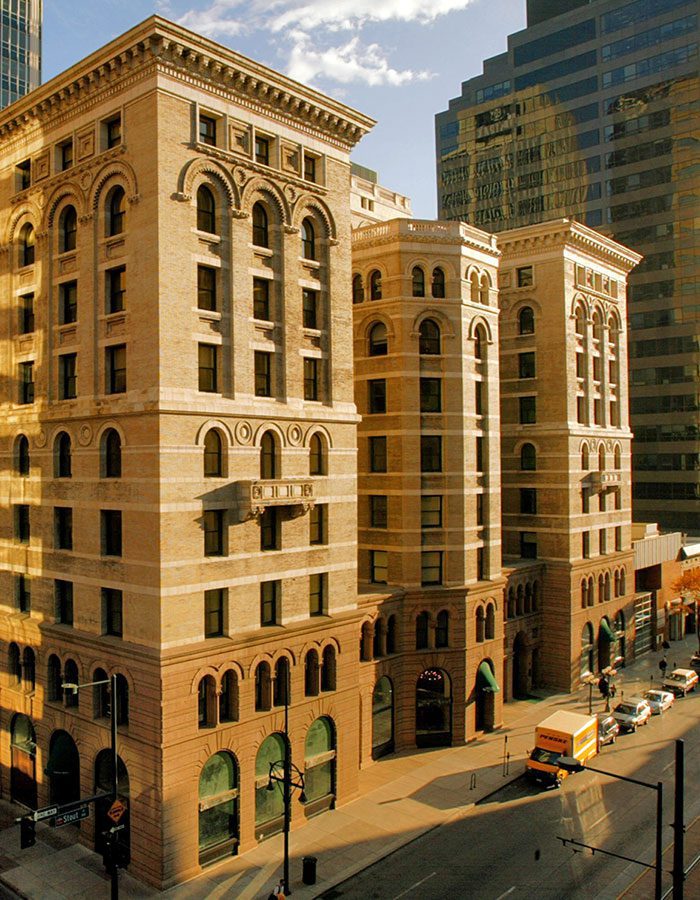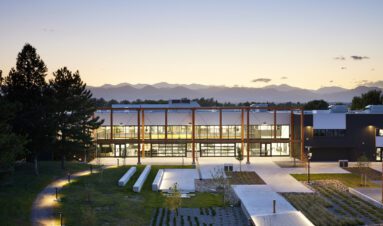Equitable Building
730 17th Street

Fast Facts
Architect: Andrews Jaques and Rantoul
Architectural Style: Italian Renaissance Revival
Year Built: 1892
Designation: National Register of Historic Places
Neighborhood: Downtown
Year Renovated:
Handicap Accessible
Equitable Building
The Equitable Assurance Society of New York built the Equitable Building in 1892 to serve as the company’s western office and attracted other financial concerns to 17th Street and the Central Business District. By 1893, it was home for Colorado’s executive offices during construction of the State Capitol. The city’s leading law firms, the First National Bank of Denver and the Denver & Rio Grande Railroad all moved in shortly after the 1893 grand opening. By 1920, the leading stockbrokers were here and people often visited to watch the Equitable Building’s ticker tape.
The Equitable Building was laid out in the shape of two “E’s” laid back to back, and thus features lightwells that provide natural light to most offices. The exterior has a pinkish-gray Colorado granite base on the first two floors and pressed brick above. The building does not have a steel frame skeleton. The huge granite blocks of the first two stories support seven additional stories. The architects employed as much Classical embellishment as possible, including dentils, egg and dart molding and a bound acanthus. The fifth floor Palladian window and balcony are adorned with nude cherubs or amorini (Italian for “little loved ones”). Terra cotta from the Denver Terra Cotta Company is used for courses between floors and on the elaborate cornice. The banding helps separate the upper floors into successive horizontal wedding cake layers.
The interior is one of the most beautiful in the city: it seems Equitable wanted nothing but the best. Marble from France, Italy, Vermont and Tennessee enhance the interior. The lobby is illuminated by a tripartite Tiffany window and elegant chandeliers, and is lined with buttery yellow marble, deep-red marble floors, marble pillars and a glass mosaic lined groin vault ceiling. The grand bronze staircase leads to a landing with a spectacular Tiffany stained glass window, “The Genius of Insurance,” in which the Equitable Company, represented by Minerva, the Greek goddess of protection, comforts a bereft widow and orphan.
Although the building opened to great acclaim, property values declined after the 1893 crash. Equitable rents did not reach pre-crash prices until 1902. In 1908, William Barth, president of the Denver & Rio Grande Railroad, purchased the building for $1.3 million. Ownership changed two more times prior to the effects of the Great Depression, and in 1934 the owners defaulted on a $50,000 loan and the structure went into foreclosure. Charlotte Barth Howell, granddaughter of the previous owner William Barth, purchased the building for $950,000. The building changed owners in 1956, 1962 and 1968, each time selling for about $2.5 million. In 1977, a Canadian-based company purchased the building and restored it to its 1893 grandeur.
References
Noel, Thomas J. & Wharton, Nicholas J. (2016). Denver Landmarks and Historic Districts Second Edition. Boulder, Colorado: University Press of Colorado.
Voelz Chandler, M. (2013). Guide to Denver Architecture. Denver, Colorado: Fulcrum Group.
